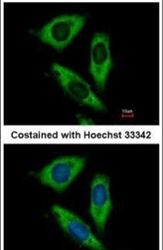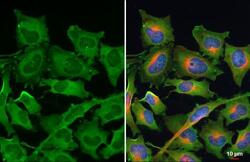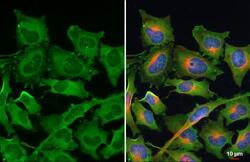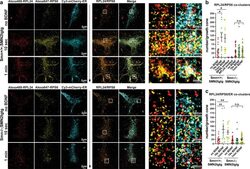Antibody data
- Antibody Data
- Antigen structure
- References [1]
- Comments [0]
- Validations
- Immunocytochemistry [3]
- Other assay [1]
Submit
Validation data
Reference
Comment
Report error
- Product number
- PA5-30157 - Provider product page

- Provider
- Invitrogen Antibodies
- Product name
- RPL24 Polyclonal Antibody
- Antibody type
- Polyclonal
- Antigen
- Recombinant full-length protein
- Description
- Recommended positive controls: A549. Predicted reactivity: Mouse (100%), Rat (100%), Zebrafish (88%), Xenopus laevis (93%), Cat (100%), Chicken (97%), Rhesus Monkey (100%), Bovine (100%). Store product as a concentrated solution. Centrifuge briefly prior to opening the vial.
- Reactivity
- Human, Mouse
- Host
- Rabbit
- Isotype
- IgG
- Vial size
- 100 μL
- Concentration
- 0.86 mg/mL
- Storage
- Store at 4°C short term. For long term storage, store at -20°C, avoiding freeze/thaw cycles.
Submitted references Impaired dynamic interaction of axonal endoplasmic reticulum and ribosomes contributes to defective stimulus-response in spinal muscular atrophy.
Deng C, Reinhard S, Hennlein L, Eilts J, Sachs S, Doose S, Jablonka S, Sauer M, Moradi M, Sendtner M
Translational neurodegeneration 2022 Jun 2;11(1):31
Translational neurodegeneration 2022 Jun 2;11(1):31
No comments: Submit comment
Supportive validation
- Submitted by
- Invitrogen Antibodies (provider)
- Main image

- Experimental details
- Immunofluorescent analysis of RPL24 in paraformaldehyde-fixed HeLa cells using a RPL24 polyclonal antibody (Product # PA5-30157) at a 1:500 dilution.
- Submitted by
- Invitrogen Antibodies (provider)
- Main image

- Experimental details
- RPL24 Polyclonal Antibody detects RPL24 protein at cytoplasm by immunofluorescent analysis. Sample: HeLa cells were fixed in 4% paraformaldehyde at RT for 15 min. Green: RPL24 stained by RPL24 Polyclonal Antibody (Product # PA5-30157) diluted at 1:200. Red: alpha Tubulin, a cytoskeleton marker, stained by alpha Tubulin Polyclonal Antibody [GT114] (Product # MA5-31466) diluted at 1:1,000. Blue: Fluoroshield with DAPI .
- Submitted by
- Invitrogen Antibodies (provider)
- Main image

- Experimental details
- RPL24 Polyclonal Antibody detects RPL24 protein at cytoplasm by immunofluorescent analysis. Sample: HeLa cells were fixed in 4% paraformaldehyde at RT for 15 min. Green: RPL24 stained by RPL24 Polyclonal Antibody (Product # PA5-30157) diluted at 1:200. Red: alpha Tubulin, a cytoskeleton marker, stained by alpha Tubulin Polyclonal Antibody [GT114] (Product # MA5-31466) diluted at 1:1,000. Blue: Fluoroshield with DAPI .
Supportive validation
- Submitted by
- Invitrogen Antibodies (provider)
- Main image

- Experimental details
- Ribosome responsiveness to the BDNF/TrkB signaling as well as ribosome/ER tethering are impaired in Smn-deficient axon terminals. a BDNF-stimulated Smn + / + ;SMN2tgtg and Smn -/- ;SMN2tgtg motoneurons expressing mCherry-KDEL were stained against RPL24, RPS6 and mCherry-KDEL. Growth cones were imaged by SIM. White boxes indicate enlarged ROIs within growth cones. In control but not Smn -/- ;SMN2tgtg motoneurons, BDNF induces formation of RPL24/RPS6 co-clusters that colocalize with the axonal ER at 10 s and 1-min poststimulation. b Smn -/- ;SMN2tgtg motoneurons do not exhibit increased number of RPL24/RPS6 co-clusters upon stimulation (n.s., P = 0.9999; n = 21-23 cells), in contrast to Smn + / + ;SMN2tgtg (* P = 0.0147 for no BDNF vs. 10-s BDNF; * P = 0.0210 for no BDNF vs. 1-min BDNF; n = 13-16 cells from 3 independent experiments). In control experiments, either RPL24 or RPS6 antibodies were omitted to exclude the crosstalk between channels. Colocalization analysis detected almost no co-clusters in the growth cones of control neurons (see also Additional file 1 : Fig. S3). c In Smn + / + ;SMN2tgtg motoneurons, the number of RPL24/RPS6 co-clusters that colocalize with ER increases significantly within 10 s and 1-min of stimulation (** P = 0.0089 for no BDNF vs. 10 s BDNF; ** P = 0.0092 for no BDNF vs. 1-min BDNF; n = 13-16 cells from 3 independent experiments). In Smn -/- ;SMN2tgtg motoneurons the number of RPL24/RPS6 co-clusters that associate with ER does not increase upon
 Explore
Explore Validate
Validate Learn
Learn Western blot
Western blot Immunocytochemistry
Immunocytochemistry Immunohistochemistry
Immunohistochemistry